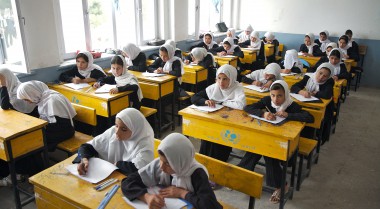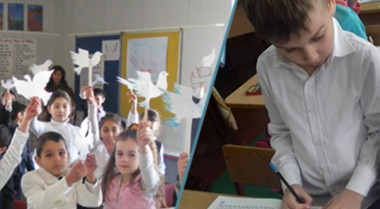
Why Peace Education is More Urgent Than Ever
It seems an unfamiliar sound now – school bells ringing and children running and talking excitedly on their way back to their classroom and face-to-face learning. After almost two years of studying in a world of COVID-19 restrictions, millions of students are slowly coming back to school. However, the experiences of remote learning and disrupted schooling has, in many countries, amplified pre-existing inequalities, exclusion and stress. This impact will continue to challenge educators, making a return to “the old normal” impossible unless there is a strong emphasis on peace education and Social-Emotional Learning.
Pre-COVID-19: Unequal Learning Environment
Before the global pandemic ravaged all continents, the world was already lagging behind in achieving its ambitious goal of inclusive quality education, also known as Sustainable Development Goal #4. This is especially true for countries affected by war and conflict. For instance, in Moldova and its breakaway region, Transnistria, children growing up on the opposite river banks of the Dniester river distrust and disrespect one another because they are not evolving in an educational environment that promotes a culture of community, peace and non-violence.
A Generational Catastrophe: Learning and Development Disrupted
COVID-19 has added additional stress to an already challenging educational environment in fragile and (post-)conflict situations and robbed millions of children of learning opportunities. This is especially true for those children not able to participate in remote learning. As a consequence, students and teachers are facing enormous psycho-social challenges rooted in social and technological isolation and disrupted learning.
The list of psycho-social challenges is long, including increased stress and anxiety, loss of trust and confidence in oneself, and online bullying. Teachers are faced with the gigantic task of managing students mental health while at the same time seeking to re-establish effective study habits focusing on student wellbeing and developing a positive climate for learning. Often teachers are not trained adequately to provide supportive psycho-social conditions.
Research shows that stress, distrust and stereotyping of the ‘other’ are known as conflict triggers which can lead to violence, social injustice and a disregard for human rights. They hold the potential to make people choose violence over dialogue and hateful and hurtful remarks over words of support and encouragement.
Post-COVID-19: From Disruption to Recovery based on Peace Education
As schools begin to open, there is an opportunity to reset learning environments so that every child can feel safe whether face-to-face or during online learning. But for this to happen, schools will need to focus on overcoming the psycho-social toll of COVID-19, especially in countries affected by war and conflict. Trust us when we say that this can be done by focusing on peace education. Particularly Social-Emotional Learning can make a significant contribution to the repair and recovery of school communities impacted by disrupted learning.
Peace education quite literally means the ‘’teaching for peace.’’ Peace education is taught through curricula that explore principles and values dedicated to achieving more peaceful, inclusive, sustainable and just societies. Peace education approaches are typically student-centred, participatory and collaborative in which knowledge, skills and capabilities for listening, empathy and compassion are developed. As a result of peace education, students gain a better understanding of the cause and effect of harmful social interactions, as well as the skills to intervene to break the cycle of conflict and violence such as bullying. Educators who are trained in peace education can create and sustain cooperative and constructive classroom climates.
Social-Emotional Learning is a peace education method that supports students’ understanding of difference, management of emotions, increase empathy, enhance active listening and their abilities to work together to solve problems and see each other’s perspectives - laying the foundation to live together.
Peace education works: we’ve been doing it for years!
For over 15 years, we at GPPAC have collaborated with schools, teachers, ministries and civil society to embed peace education in curricula and to develop peace education courses for both young and old, fit to local contexts and needs. For instance:
- In Serbia, Montenegro, Australia, Kyrgyzstan, the United States and Afghanistan, we supported the integration of Social-Emotional Learning skills into school curricula.
- In Colombia and Peru, we contributed to the design of national public policies on socio-emotional education and citizenship.
- In Bosnia, we have provided capacity building training for the Bosnian Ministry of Education for over 20 years.
Such successes demonstrate the need to advance peace education, particularly in the face of the ongoing global pandemic. By doing so today’s students, those most affected by COVID-19 gain the knowledge, skills and abilities to support their communities for a better tomorrow - no matter what the future holds.

